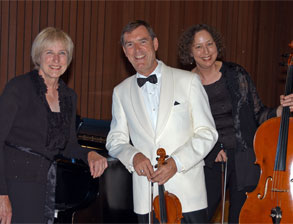|
Symphony
FROM THE NEW WORLD TO THE OLD WORLD
by Peter Lert
Saturday, June 14, 2025
Chamber
MC2 DUO RECITAL CLOSES 222'S SEASON
by Terry McNeill
Saturday, June 14, 2025
Choral and Vocal
CANTIAMO SONOMA'S LUSCIOUS A CAPELLA SINGING IN SEASON ENDING CONCERT
by Pamela Hicks Gailey
Sunday, June 8, 2025
Symphony
SRS SEASON ENDS WITH RESOUNDING TA-TA-TA-BANG
by Terry McNeill
Sunday, June 1, 2025
Symphony
YOUTHFUL VIRTUOSITY ON DISPLAY AT USO'S MAY CONCERTS
by Peter Lert
Saturday, May 17, 2025
Symphony
MYSTICAL PLANETS AND LIVELY GERSHWIN ORTIZ AT FINAL SRS CONCERT
by Peter Lert
Sunday, May 4, 2025
Symphony
VSO'S CONCERT MUSIC OF TIME, MUSIC OF PLACE
by Peter Lert
Sunday, April 27, 2025
VOCAL ELEGANCE AND FIRE AT THE 222'S RECITAL APRIL 26
by Pamela Hicks Gailey
Saturday, April 26, 2025
CANTIAMO SONOMA SINGS AN INSPIRED GOOD FRIDAY MOZART REQUIEM CONCERT
by Pamela Hicks Gailey
Friday, April 18, 2025
DRAMATIC SHOSTAKOVICH SYMPHONY CLOSES PHILHARMONIC'S 25TH SEASON
by Terry McNeill
Sunday, April 13, 2025
|
 |
 Sonoma State University's Trio Navarro |
BRIDGE AND TURINA WORKS SPARKLE IN TRIO NAVARRO CONCERT AT SSU
by Terry McNeill
Sunday, November 6, 2011
An old musical friend was juxtaposed with two not-quite-so-old interlopers Nov. 6 when the venerable Trio Navarro opened their 2011-2012 season at Sonoma State University’s Green Music Center 1028. Mendelssohn’s iconic D Minor Trio was the old shoe and Trios by Bridge and Turina were the unfamiliar fare.
In a surprise program alignment the rarely-played Bridge C Minor Fantasie Trio and Turina’s Op. 35 Trio comprised the long second half, and both works are episodic and difficult to get to know in a single hearing. The Turina, from 1926 and written in a style that combines Spanish elements with arguably early 20th Century French style, received a strong performance led at the outset by violinist Roy Malan’s penetrating high register. The rhapsodic nature changed quickly in the following Theme and (5) Variations to a more somber tone. Mr. Malan alternated bright pizzicato phrases with cellist Jill Brindel, combined with intriguing rhythmic syncopations. Pianist Marilyn Thompson deftly played the jazz-influenced Basque dance (zortziko) in the third variation, the obverse to the murmuring pianissimo ending in the strings.
The Trio attached the concluding movement aggressively, the piano part marching up and down the keyboard and heralding themes from the preceding movements.
Bridge’s first Trio (Fantasie) dates from 1908 and is in a single movement. The Navarro’s quick and impulsive opening set the stage for the rich but often darkly-tines melodic lines from the cello and violin, the specter of Faure not far away. The ensemble was particularly good in the swirl of notes, Ms. Thompson pushing the pace. The noble second theme was elegantly played by Ms. Brindel with a broad vibrato and subtle ritards are phrase endings. On either side of the beguiling central Andante the performance sparkled and often surged. It was music in a performance that was optimistic when compared to the intricate Turina.
The concert began with the first Mendelssohn Trio, Op. 49, perhaps the most played work now before the public for this combination of instruments. The performance was dedicated by Ms. Brindel to the memory of her mother who had died the previous day. In the opening Molto allegro ed agitato with its extended patrician cello solo the chosen approach was slow and lyrical, lacking the usual speed and snap that characterizes much of the music. Mr. Malan’s tone and projection, soaring during the Turina and Bridge, was here often covered by Ms. Brindel in a venue that seems to love low frequencies. Ms. Thompson, a consummate chamber music pianist, chose clarity over drama and never covered her partners. It was playing of refinement and proportion but lacked energy.
In the lyrical Andante the tempo was again relaxed with subtle voice leading from the pianist and cellist, and Ms. Thompson varying the character of the repeats with discerning dynamic changes. The charming Scherzo, always a crowd pleaser, found Mr. Malan making small portamento to lovely effect. In the concluding rondo (Allegro) Ms. Brindel dug deep, projecting a bass line to compliment the galloping scales from the pianist. Missing in the sonic balance were some of the sforzando outbursts, especially from the piano part, that add spice and make this revered work feel like a welcome acquaintance.
Mention needs to be made of the room's piano, celebrating its 100th birthday and a favorite instrument of Ms. Thompson. There is captivating music coming in the piano’s next century, and plenty of life in the old girl yet.
|
